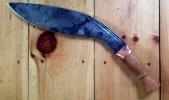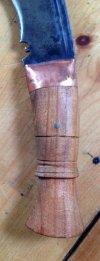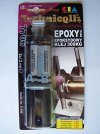- Joined
- Feb 20, 2014
- Messages
- 2,045
Bubbles bought me a Bhojpure from AC about ten years ago.
Paid extra for special select.
Blade & handle both beat to spit. Chunks missing from edge. Blade wavy, not flat. Tip gone. Loose steel bolster.
Been sitting here in the office ever since, waiting for somebody to knock on the door & say the magic words: "Hi. I'm the best person on the planet for old khukuri restoration, and I want to do yours."
So far, hasn't happened & I am NOT a DIY kinda guy.
Always envy those who are, but there's no hope whatever of anything good coming of any attempts by me.
Good luck on the project.
Denis
Now you are someone that I can relate to Denis. I really love talking with all these super craftsman-y types we have around here. I love seeing how they do all the glorious things they do. But no one wants to see what would happen if I tried it LOL. Probably scare even the ones that know what they are doing away from wanting to try after they see how I would do.
When I was setting some rat-tailed scandinavian blades into homemade wooden handles, I was a little concerned with security. I filed some notches into the rat tails, and then set them into the handle holes with epoxy. I haven't had any issues with the blades coming loose. They may have been just fine without such notches.
It's something (non traditional) to think about with a rat-tailed khukuri that won't be peened at the end of the handle.
Wow great idea Howard. Just adds that extra retention grasp against the tail sliding loose.






